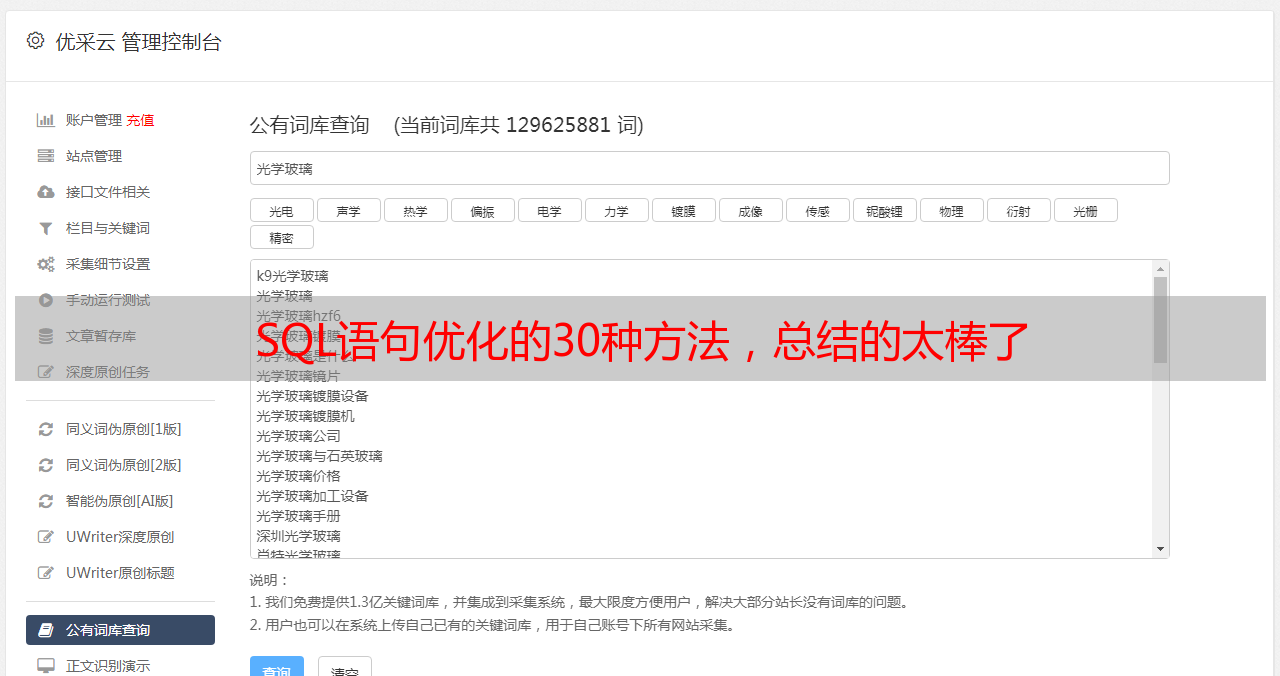SQL语句优化的30种方法,总结的太棒了
优采云 发布时间: 2022-07-15 13:49SQL语句优化的30种方法,总结的太棒了
在公众号后台回复:JGNB,可获取杰哥原创的 PDF 手册。
1、对查询进行优化,应尽量避免全表扫描,首先应考虑在 where 及 order by 涉及的列上建立索引。
2、应尽量避免在 where 子句中使用!=或操作符,否则将引擎放弃使用索引而进行全表扫描。
3、应尽量避免在 where 子句中对字段进行 null 值判断,否则将导致引擎放弃使用索引而进行全表扫描,如:
select id from t where num is null <br />
可以在num上设置默认值0,确保表中num列没有null值,然后这样查询:
select id from t where num=0 <br />
4、应尽量避免在 where 子句中使用 or 来连接条件,否则将导致引擎放弃使用索引而进行全表扫描,如:
select id from t where num=10 or num=20 <br />
可以这样查询:
select id from t where num=10 <br />union all <br />select id from t where num=20 <br />
5、下面的查询也将导致全表扫描:
select id from t where name like '%abc%' <br />
若要提高效率,可以考虑全文检索。
6、in 和 not in 也要慎用,否则会导致全表扫描,如:
select id from t where num in(1,2,3) <br />
对于连续的数值,能用 between 就不要用 in 了:
select id from t where num between 1 and 3 <br />
7、如果在 where 子句中使用参数,也会导致全表扫描。因为SQL只有在运行时才会解析局部变量,但优化程序不能将访问计划的选择推迟到运行时;它必须在编译时进行选择。然而,如果在编译时建立访问计划,变量的值还是未知的,因而无法作为索引选择的输入项。如下面语句将进行全表扫描:
select id from t where num=@num <br />
可以改为强制查询使用索引:
select id from t with(index(索引名)) where num=@num <br />
8、应尽量避免在 where 子句中对字段进行表达式操作,这将导致引擎放弃使用索引而进行全表扫描。如:
select id from t where num/2=100 <br />
应改为:
select id from t where num=100*2 <br />
9、应尽量避免在where子句中对字段进行函数操作,这将导致引擎放弃使用索引而进行全表扫描。如:
select id from t where substring(name,1,3)='abc'--name以abc开头的id <br />select id from t where datediff(day,createdate,'2005-11-30')=0--'2005-11-30'生成的id <br />
应改为:
<p>select id from t where name like 'abc%' <br />select id from t where createdate>='2005-11-30' and createdate



